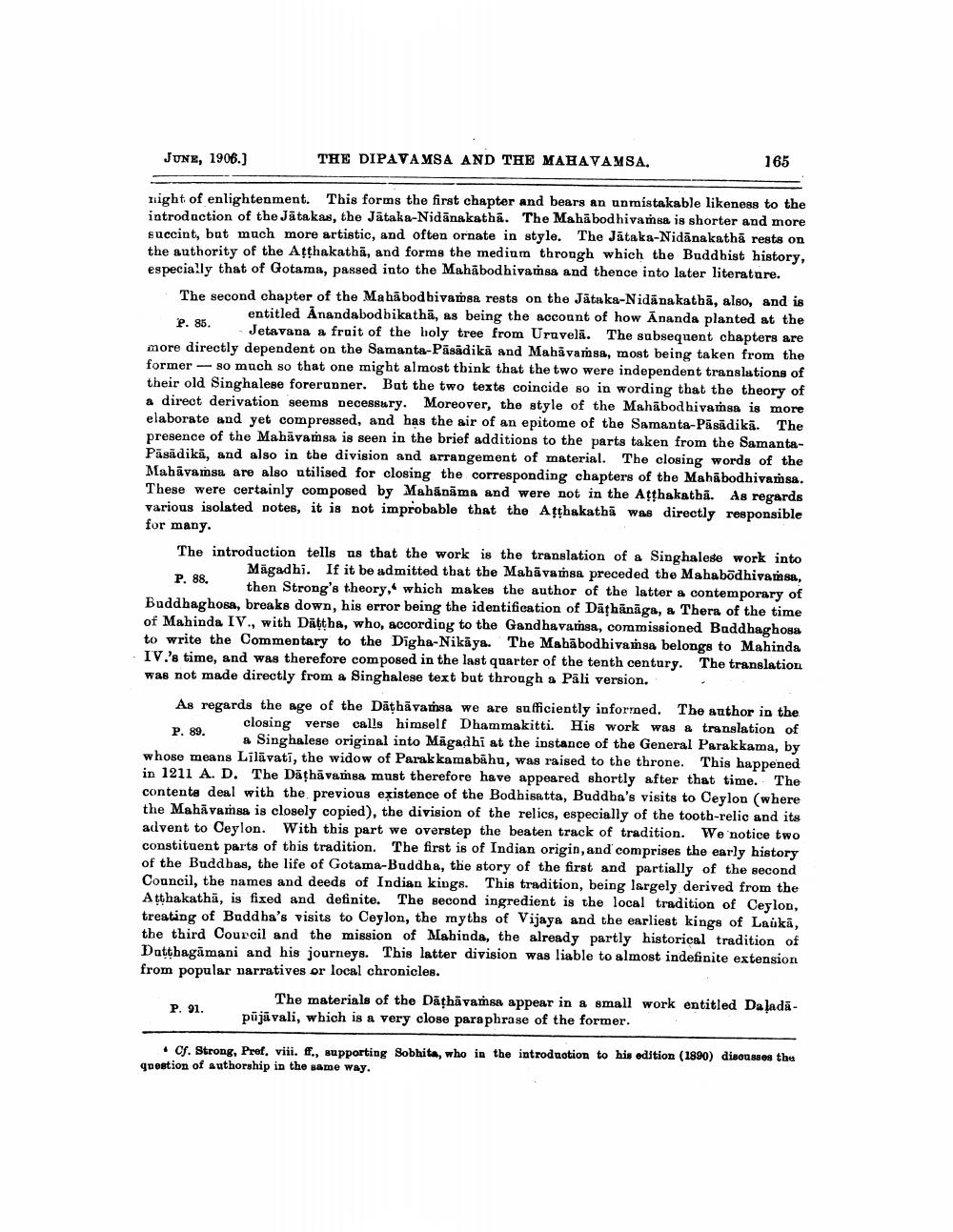________________
THE DIPAVAMSA AND THE MAHAVAMSA.
night of enlightenment. This forms the first chapter and bears an unmistakable likeness to the introduction of the Jätakas, the Jataka-Nidanakatha. The Mahabodhivamsa is shorter and more succint, but much more artistic, and often ornate in style. The Jātaka-Nidanakatha rests on the authority of the Aṭṭhakatha, and forms the medium through which the Buddhist history, especially that of Gotama, passed into the Mahabodhivamsa and thence into later literature.
JUNE, 1906.]
165
The second chapter of the Mahabodhivamsa rests on the Jataka-Nidānakatha, also, and is entitled Anandabodhikatha, as being the account of how Ananda planted at the P. 85. Jetavana a fruit of the holy tree from Uruvela. The subsequent chapters are more directly dependent on the Samanta-Pasadika and Mahāvamsa, most being taken from the former so much so that one might almost think that the two were independent translations of their old Singhalese forerunner. But the two texts coincide so in wording that the theory of a direct derivation seems necessary. Moreover, the style of the Mahabodhivamsa is more elaborate and yet compressed, and has the air of an epitome of the Samanta-Pasādikā. The presence of the Mahāvamsa is seen in the brief additions to the parts taken from the SamantaPäsädikā, and also in the division and arrangement of material. The closing words of the Mahāvamsa are also utilised for closing the corresponding chapters of the Mahabodhivamsa. These were certainly composed by Mahänāma and were not in the Aṭṭhakatha. As regards various isolated notes, it is not improbable that the Atthakatha was directly responsible for many.
The introduction tells us that the work is the translation of a Singhalese work into Mägadhi. If it be admitted that the Mahāvamsa preceded the Mahabodhivamsa, P. 88. then Strong's theory, which makes the author of the latter a contemporary of Buddhaghosa, breaks down, his error being the identification of Dathanaga, a Thera of the time of Mahinda IV., with Dattha, who, according to the Gandhavamsa, commissioned Buddhaghosa to write the Commentary to the Digha-Nikaya. The Mahabodhivamsa belongs to Mahinda IV.'s time, and was therefore composed in the last quarter of the tenth century. The translation was not made directly from a Singhalese text but through a Päli version.
As regards the age of the Daṭhāvamsa we are sufficiently informed. The author in the closing verse calls himself Dhammakitti. His work was a translation of P. 89. a Singhalese original into Magadhi at the instance of the General Parakkama, by whose means Lilavati, the widow of Parakkamabahu, was raised to the throne. This happened in 1211 A. D. The Daṭhāvamsa must therefore have appeared shortly after that time. The contents deal with the previous existence of the Bodhisatta, Buddha's visits to Ceylon (where the Mahavamsa is closely copied), the division of the relics, especially of the tooth-relic and its advent to Ceylon. With this part we overstep the beaten track of tradition. We notice two constituent parts of this tradition. The first is of Indian origin, and comprises the early history of the Buddhas, the life of Gotama-Buddha, the story of the first and partially of the second Council, the names and deeds of Indian kings. This tradition, being largely derived from the Atthakatha, is fixed and definite. The second ingredient is the local tradition of Ceylon, treating of Buddha's visits to Ceylon, the myths of Vijaya and the earliest kings of Laukā, the third Courcil and the mission of Mahinda, the already partly historical tradition of Datthagamani and his journeys. This latter division was liable to almost indefinite extension from popular narratives or local chronicles.
P. 91.
The materials of the Daṭhāvamsa appear in a small work entitled Daladapūjāvali, which is a very close paraphrase of the former.
Cf. Strong, Pref. viii. ff., supporting Sobhita, who in the introduction to his edition (1890) discusses the question of authorship in the same way.




